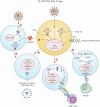APOBEC3 Proteins in Viral Immunity
- PMID: 26546688
- PMCID: PMC4638160
- DOI: 10.4049/jimmunol.1501504
APOBEC3 Proteins in Viral Immunity
Abstract
Apolipoprotein B editing complex 3 family members are cytidine deaminases that play important roles in intrinsic responses to infection by retroviruses and have been implicated in the control of other viruses, such as parvoviruses, herpesviruses, papillomaviruses, hepatitis B virus, and retrotransposons. Although their direct effect on modification of viral DNA has been clearly demonstrated, whether they play additional roles in innate and adaptive immunity to viruses is less clear. We review the data regarding the various steps in the innate and adaptive immune response to virus infection in which apolipoprotein B editing complex 3 proteins have been implicated.
Copyright © 2015 by The American Association of Immunologists, Inc.
Figures

References
-
- Sheehy AM, Gaddis NC, Choi JD, Malim MH. Isolation of a human gene that inhibits HIV-1 infection and is suppressed by the viral Vif protein. Nature. 2002;418:646–650. - PubMed
-
- Sobieszczyk ME, Lingappa JR, McElrath MJ. Host genetic polymorphisms associated with innate immune factors and HIV-1. Curr Opin HIV AIDS. 2011;6:427–434. - PubMed
-
- Daugherty MD, Malik HS. Rules of engagement: molecular insights from host-virus arms races. Annual review of genetics. 2012;46:677–700. - PubMed
Publication types
MeSH terms
Substances
Grants and funding
LinkOut - more resources
Full Text Sources
Other Literature Sources
Medical

